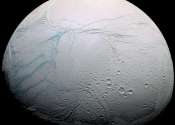Orbital eccentricity may have led to young underground ocean on Saturn's moon Mimas
Saturn's moon Mimas could have grown a huge underground ocean as its orbital eccentricity decreased to its present value and caused its icy shell to melt and thin.

Saturn's moon Mimas could have grown a huge underground ocean as its orbital eccentricity decreased to its present value and caused its icy shell to melt and thin.
Planetary Sciences
Apr 15, 2024
0
78

Decades before any probe dips a toe—and thermometer—into the waters of distant ocean worlds, Cornell astrobiologists have devised a novel way to determine ocean temperatures based on the thickness of their ice shells, ...
Planetary Sciences
Feb 29, 2024
0
20

In 2015, when NASA's New Horizons spacecraft encountered the Pluto-Charon system, the Southwest Research Institute-led science team discovered interesting, geologically active objects instead of the inert icy orbs previously ...
Astronomy
Feb 7, 2023
0
652

Comet strikes on Jupiter's moon Europa could help transport critical ingredients for life found on the moon's surface to its hidden ocean of liquid water—even if the impacts don't punch completely through the moon's icy ...
Astrobiology
Dec 15, 2022
0
60

Below Europa's thick icy crust is a massive, global ocean where the snow floats upwards onto inverted ice peaks and submerged ravines. The bizarre underwater snow is known to occur below ice shelves on Earth, but a new study ...
Astrobiology
Aug 15, 2022
0
709

When Galileo pointed his telescope at Jupiter 400 years ago, he saw three blobs of light around the giant planet, which he at first thought were fixed stars. He kept looking, and eventually, he spotted a fourth blob and noticed ...
Space Exploration
Jul 12, 2022
0
21

Europa is a prime candidate for life in our solar system, and its deep saltwater ocean has captivated scientists for decades. But it's enclosed by an icy shell that could be miles to tens of miles thick, making sampling it ...
Astrobiology
Apr 19, 2022
0
1547

In 2006, the Cassini spacecraft recorded geyser curtains shooting forth from "tiger stripe" fissures near the south pole of Saturn's moon Enceladus—sometimes as much as 200 kilograms of water per second. A new study suggests ...
Astronomy
Mar 22, 2022
3
1615

The first of the gas-giant orbiter's back-to-back flybys will provide a close encounter with the massive moon after over 20 years.
Space Exploration
Jun 4, 2021
5
562

Buried beneath 20 kilometers of ice, the subsurface ocean of Enceladus—one of Saturn's moons—appears to be churning with currents akin to those on Earth.
Planetary Sciences
Mar 25, 2021
0
2537